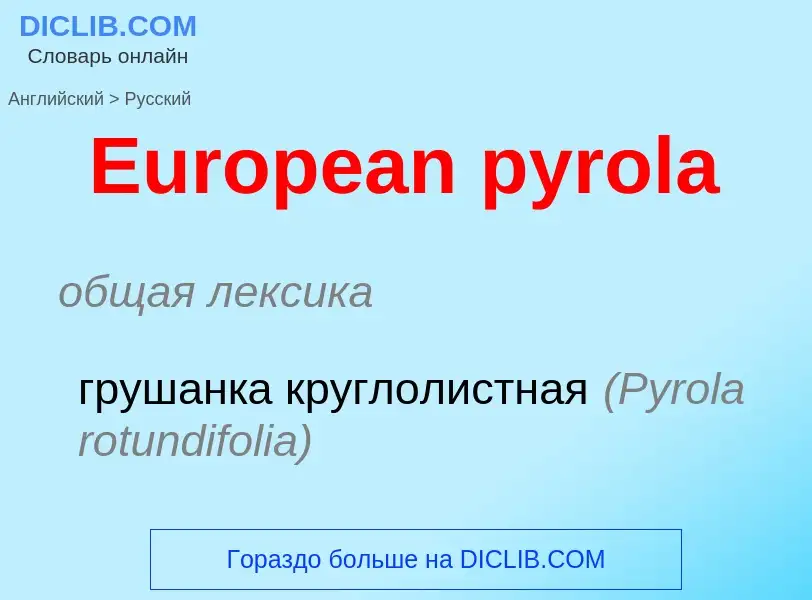Введите слово или словосочетание на любом языке 👆
Язык:
Перевод и анализ слов искусственным интеллектом ChatGPT
На этой странице Вы можете получить подробный анализ слова или словосочетания, произведенный с помощью лучшей на сегодняшний день технологии искусственного интеллекта:
- как употребляется слово
- частота употребления
- используется оно чаще в устной или письменной речи
- варианты перевода слова
- примеры употребления (несколько фраз с переводом)
- этимология
European pyrola - перевод на Английский
РОД РАСТЕНИЙ
Pyrola
European pyrola
общая лексика
грушанка круглолистная (Pyrola rotundifolia)
Indo-European
LANGUAGE FAMILY NATIVE TO WESTERN AND SOUTHERN EURASIA
Indo-Germanic; Indo-Germanic languages; Indo-germanic languages; Indo-germanic; Indo-European family; Indo-European Languages; Indo-European language family; IE family; I.E. family; I. E. family; I-E family; I.-E. family; IE group; IE Group; IE languages; IE Languages; IE language family; IE Language Family; Indo-european language family; Indo european; Indo European; Indo-Germanic race; Indo-european language group; Indo-European people; North Indo-European; Indoeuropean languages; Indo europian languages; Indo-Europeans; Indo-European language; Indo-European family of languages; Indo-European peoples; Indogermanic; Indo-Germanic language; Indo European language; Indo-European; Classification of Indo-European language; Indo European languages; Indo-european languages; ISO 639:ine; Indo-European languages family; Spread of Indo-European languages; Balto-Slavo-Germanic; Balto-Slavo-Germanic languages; Indo-European languages language; Indo-European linguistic group; History of Indo-European linguistics
Indo-European adj. индоевропейский
Indo-European languages
LANGUAGE FAMILY NATIVE TO WESTERN AND SOUTHERN EURASIA
Indo-Germanic; Indo-Germanic languages; Indo-germanic languages; Indo-germanic; Indo-European family; Indo-European Languages; Indo-European language family; IE family; I.E. family; I. E. family; I-E family; I.-E. family; IE group; IE Group; IE languages; IE Languages; IE language family; IE Language Family; Indo-european language family; Indo european; Indo European; Indo-Germanic race; Indo-european language group; Indo-European people; North Indo-European; Indoeuropean languages; Indo europian languages; Indo-Europeans; Indo-European language; Indo-European family of languages; Indo-European peoples; Indogermanic; Indo-Germanic language; Indo European language; Indo-European; Classification of Indo-European language; Indo European languages; Indo-european languages; ISO 639:ine; Indo-European languages family; Spread of Indo-European languages; Balto-Slavo-Germanic; Balto-Slavo-Germanic languages; Indo-European languages language; Indo-European linguistic group; History of Indo-European linguistics
индоевропейские языки
Определение
Грушанка
(Pyrola)
род растений семейства грушанковых. Многолетние травы с ползучими корневищами. Листья кожистые, расположены в нижней части стебля. Цветки пятичленные; венчик белый, зеленоватый или красноватый. Плод - пятигнёздная коробочка. Около 40 видов в Северном полушарии, главным образом в умеренных широтах. В СССР - 7 видов, растущих преимущественно в лесной зоне, в мшистых хвойных и сметанных лесах. Наиболее часто встречаются Г. круглолистная (P. rotundifolia) и Г. малая (P. minor). Г. разводят иногда как декоративные в тенистых местах парков и садов.
Википедия
Грушанка

Груша́нка, или грушо́вка (лат. Pýrola) — род цветковых растений семейства Вересковые.
Энциклопедический словарь Брокгауза и Ефрона указывает на грушанку (грушовку) как на растение, вызывающее у животных «кровяную мочу».



![Dutch]]}} Dutch]]}}](https://commons.wikimedia.org/wiki/Special:FilePath/Americaslanguages (orthographic projection)-2.png?width=200)
![[[Franz Bopp]] was a pioneer in the field of comparative linguistic studies. [[Franz Bopp]] was a pioneer in the field of comparative linguistic studies.](https://commons.wikimedia.org/wiki/Special:FilePath/Franz Bopp (2).jpg?width=200)

![Scheme of Indo-European language dispersals from c. 4000 to 1000 BCE according to the widely held [[Kurgan hypothesis]].<br>– Center: Steppe cultures<br>1 (black): Anatolian languages (archaic PIE)<br>2 (black): Afanasievo culture (early PIE)<br>3 (black) Yamnaya culture expansion (Pontic-Caspian steppe, Danube Valley) (late PIE)<br>4A (black): Western Corded Ware<br>4B-C (blue & dark blue): Bell Beaker; adopted by Indo-European speakers<br>5A-B (red): Eastern Corded ware<br>5C (red): Sintashta (proto-Indo-Iranian)<br>6 (magenta): Andronovo<br>7A (purple): Indo-Aryans (Mittani)<br>7B (purple): Indo-Aryans (India)<br>[NN] (dark yellow): proto-Balto-Slavic<br>8 (grey): Greek<br>9 (yellow):Iranians<br>– [not drawn]: Armenian, expanding from western steppe Scheme of Indo-European language dispersals from c. 4000 to 1000 BCE according to the widely held [[Kurgan hypothesis]].<br>– Center: Steppe cultures<br>1 (black): Anatolian languages (archaic PIE)<br>2 (black): Afanasievo culture (early PIE)<br>3 (black) Yamnaya culture expansion (Pontic-Caspian steppe, Danube Valley) (late PIE)<br>4A (black): Western Corded Ware<br>4B-C (blue & dark blue): Bell Beaker; adopted by Indo-European speakers<br>5A-B (red): Eastern Corded ware<br>5C (red): Sintashta (proto-Indo-Iranian)<br>6 (magenta): Andronovo<br>7A (purple): Indo-Aryans (Mittani)<br>7B (purple): Indo-Aryans (India)<br>[NN] (dark yellow): proto-Balto-Slavic<br>8 (grey): Greek<br>9 (yellow):Iranians<br>– [not drawn]: Armenian, expanding from western steppe](https://commons.wikimedia.org/wiki/Special:FilePath/Indo-European expansions.jpg?width=200)


